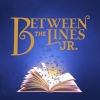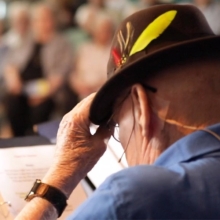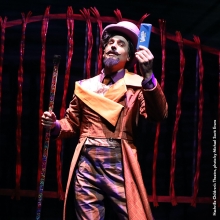Filichia Features: My Favorite Year: 2015
Filichia Features: My Favorite Year: 2015
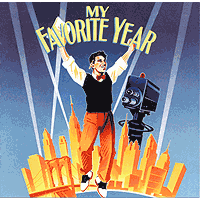 May this be your favorite year.
May this be your favorite year.
It could be if you and your theater company stage My Favorite Year.
Granted, when the musical by bookwriter Joseph Dougherty, composer Stephen Flaherty and lyricist Lynn Ahrens debuted in 1992, it wound up playing more previews (45) than official performances (36).
When it shuttered, I had a theory why it met its unfortunate fate. And, at the York Theatre Company last month, I found that my assumption held water – even in a staged reading that was part of York’s Musicals in Mufti series. My Favorite Year was greeted by a packed house that gave it warm laughter, hot applause and enough appreciation to redeem it as a solid hit.
So what went wrong in 1992? You’re guessing the book, which usually takes the blame for any short-run musical. That shouldn’t have been a problem for My Favorite Year, for the show was based on Norman Steinberg and Dennis Palumbo’s well-received 1982 screenplay.
Benjy Stone tells us that 1954 was his favorite year because he’d landed a job writing for TV’s biggest show: “King Kaiser’s Comedy Cavalcade.” There he’d fallen in love with co-worker K.C. Downing and had met Alan Swann, the movie star that had filled his youth with Saturday matinees and swashbuckling thrills.
Alas, Swann showed up drunk for his first rehearsal. Kaiser, a hot-tempered egomaniac, demanded the lush be fired. But Benjy implored his boss (who barely even knew this young writer worked for him) to give the faded star another chance. Kaiser agreed on the condition that Benjy keep Swann sober – an assignment at which he fully expected the young man to fail.
When Benjy’s mother Belle encouraged her son to bring Swann to her Brooklyn home for dinner, the star was amused at the prospect of slumming. But there Swann disclosed more than he’d expected. He divulged that he’d been negligent in keeping in touch with his now-grown daughter from one of his many ex-wives. So Benjy arranged that Swann at least see the lass from afar, which – he told us in an epilogue – eventually resulted in a nice reunion.
The 1982 film offered another subplot. Kaiser had been parodying a Mafioso in his weekly sketches, which hardly amused the thug. He threatened Kaiser with great bodily harm, which, as it turned out, he planned to inflict during a live broadcast.
As if Kaiser didn’t have enough problems. Just before showtime, Swann realized that “King Kaiser’s Comedy Cavalcade” was a live show. Without the prospect of retakes, Swann contracted terrible stage fright and bolted. But once he saw the Mafioso and his goons disrupting a scene (which the studio audience assumed was part of the sketch), he grabbed a cable and swung onto the set in swashbuckling fashion.
Truth to tell, Dougherty actually improved the screenplay by dropping the Mafioso business. What interested him were the characters’ relationships. Benjy mentioned that when he was a child, his father abandoned the family – and Swann vicariously became the father he never had. Better still, after Swann’s flight from stage fright, he returned when he learned that his daughter was in the audience, for he wanted her to be proud of him.
So with a deeper book, was the problem the score? Hardly. We’re talking Ahrens and Flaherty here, after all. They perfectly captured 1954, the last year before rock conquered the airwaves. If the title tune had debuted in that year, it would have been a Top Ten hit en route to becoming an immediate standard.
That’s the closing number, but the opening number is just as choice. “Twenty Million People” shows us what was going on backstage five minutes before “King Kaiser’s Comedy Cavalcade” was to air. Isn’t this a great way to open a musical about live TV? Aren’t you ready to raid your costume shop right now, pick the most flamboyant duds off the rack and give a fanciful ensemble to each ensemble member? (And don’t forget hats. As Kaiser says, “Hats are funny.”)
Ah, but as good as “Twenty Million People” is, My Favorite Year’s original director made a fatal mistake in how he handled Lainie Kazan, who played Belle. Kazan had been absent from Broadway since the day in 1964 when she went on for Barbra Streisand in “Funny Girl.” Since then, her two attempts to get back to Broadway had resulted in her being fired from one show and withdrawing from a second. But Kazan had played Belle in the film of My Favorite Year which resulted in a Golden Globe nomination. Now she was to make a triumphant return in its musical version.
Theatergoers love a survivor, so they were ready to give Kazan titanic entrance applause. It wasn’t to be, for halfway through “Twenty Million People,” Kazan was wheeled in, ostensibly in her Brooklyn home, telephone in hand, giving some expository dialogue to Benjy. Throughout the theater, playgoers who had had their hands poised to clap abruptly stopped when they saw that they had to hear what Kazan was saying.
A much better solution would have had the audience only HEAR Kazan’s voice through the theater’s sound system. “That’s Lainie!” theatergoers would have said and chuckled. The old dictum “Always leave them wanting more” applies here, for if the crowd had only heard Kazan voice, their appetites would have been whetted for the star’s eventual entrance.
What’s sadder is that Dougherty had written a terrific entrance for Kazan -- when Belle welcomed Swann into her home, dressed not only to the nines but to the ninetieth power. Theatergoers would have clapped their little hands off for finally seeing Kazan in the flesh, partly because of the earlier tease, partly because she was so provocatively dressed.
So if you have your own version of Lainie Kazan in your company – a star your theatergoers have come to cherish (and maybe even give entrance applause) – keep her offstage during the opening number’s telephone call so you can maximize her later entrance.
And then there was the scene in which Benjy is so intent on courting K.C. that he cannot wait for her to emerge from the ladies’ room and barges in there. Thank the Lord that K.C. has finished what she came in to do and was just about to leave. Less lucky is Benjy’s co-worker Alice, who’s still in a stall and is outraged that Benjy is so far but too near. Alice keeps demanding that he leave, and when he finally does, she comes out.
At the York, I was anticipating this scene among all others – and not merely because “The Duck Joke,” a most witty piece of material, would soon follow. No, I wanted to see if director Dan Knechtges would be smart enough to add a detail that the original director failed to include – meaning that when Alice came out of the stall, she didn’t wash her hands.
To my relief, here at York, Leslie Kritzer mimed washing as soon as she emerged. Whether Knechtges told her to – or whether Kritzer matter-of-factly included it during rehearsal and he had her keep it in – I cannot say. But I certainly can say that any Alice playing this scene MUST wash her hands after she leaves the stall.
Are you saying to yourself, “Oh, come on – a botched Kazan entrance and unwashed hands couldn’t be responsible for the show’s failure.” No – the real reason My Favorite Year didn’t score 22 years ago is that it was in the wrong theater.
The Vivian Beaumont has a thrust stage, and an old-fashioned musical (which My Favorite Year is in the optimum sense of the term) is better served by a proscenium arch. Even a painting that’s a masterpiece looks diminished if it isn’t in the right frame. At the York, the show was no longer lost in a vast expanse where actors were at the lip of the stage and far behind them was scenery.
Think I’m exaggerating? During intermission, I saw Flaherty and gave my observation. He immediately said, “Andrea Martin (the original Alice) said that when she had to deliver a joke, she didn’t know where to look in the semi-circular house with an audience surrounding her. She was used to theaters where she could look straight out and see everybody.”
Even so, Martin won a Best Featured Musical Actress Tony – because she had fine material, as do the other character actors. My Favorite Year allows you to cast your top bananas and a bunch of comics you have on hand. Here’s hoping you do as well as the York did, with Adam Chanler-Berat as Benjy, Douglas Sills as Swann, Richard Kind as Kaiser, Christine Pedi as Belle, and the aforementioned Leslie Kritzer as Alice – all up to (and some surpassing) their Broadway counterparts.
There’s much opportunity for “Professional Showbiz Comedy,” as one song goes. Just make sure you do it under a proscenium and you’ll wind up with a show beneath (to quote a show that was once Broadway’s longest-running musical) “that great triumphal arch.”
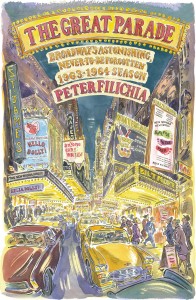 You may e-mail Peter at pfilichia@aol.com. Check out his weekly column each Tuesday at www.masterworksbroadway.com and each Friday at www.kritzerland.com. His upcoming book The Great Parade: Broadway’s Astonishing Never-to-Be Forgotten 1963-1964 Season is now available for pre-order.
You may e-mail Peter at pfilichia@aol.com. Check out his weekly column each Tuesday at www.masterworksbroadway.com and each Friday at www.kritzerland.com. His upcoming book The Great Parade: Broadway’s Astonishing Never-to-Be Forgotten 1963-1964 Season is now available for pre-order.









